-

Win a Free Custom Engraved Brass Coin!!!
As a way to introduce our brass coins to the community, we will raffle off a free coin during the month of August. Follow link ABOVE for instructions for entering.
-

PRE-ORDER SHIPS IN SCALE TODAY!
The beloved Ships in Scale Magazine is back and charting a new course for 2026!
Discover new skills, new techniques, and new inspirations in every issue.
NOTE THAT OUR FIRST ISSUE WILL BE JAN/FEB 2026
You are using an out of date browser. It may not display this or other websites correctly.
You should upgrade or use an alternative browser.
You should upgrade or use an alternative browser.
HMS GRANADO - full hull - POF kit by CAF in 1:48 - by Uwe
I've ordered my CAF Granado kit, and hope to start construction in about a month. I the meantime, I've purchased Goodwin's AotS Granado book and have been reading and studying it. Doing so has brought to light a number of questions in my mind, mostly to do with in-hull space utilization, which will affect what detail I am able to show there, and therefore (IMHO) the detail that Uwe and others building this model may/will want to know (so I hope I'm not high-jacking this thread):
- Where is 1.1km of 105mm diameter anchor cable kept? (That's 120 fathoms x 5 ropes of 13" circumference cable. 2 attached to the anchors, 3 spare.) In addition there's 240 yards of 65mm diameter cable. I see a very small rope storage are 73 on the cross section, but no good way to get anchor ropes to it, so possibly it was for rigging?
- Where would the mess table(s) and stools be located when used? The galley doesn't seem big enough.
- Where would the 60 crew sleep? Or even half of them at a time? I realize an accompanying tender would carry additional supplies and crew, but 60 men sailed the ship, apparently for days or longer at a time.
- Where would the Stream anchor be stored below deck? And could it be maneuvered there with its arm attached, or would it have to be removed?
- Where would shot for the 4-pound guns (8-12 of them) be stored. I see no provision on-deck or below. Or the 12+ half-pound guns.
- There is a bread room and galley with firehearth (at opposite ends of the vessel), but I see no food, provisions, water, flour, ale, etc. storage - no kegs or barrels or, really, room for them. Yet she sailed across oceans and was in service for many months. Mention is made the the Boatswain's storeroom was used for some items, and there's supposed to some storage under the deck at the fore, but I can't even find it on the drawings, so it is small. The two "hold" areas are decent size, but it seems like that's where the anchor ropes would have to go.
- There really seems almost no room for ballast, except possibly below the shell rooms, without impeding the small amount of headroom in other "rooms".
- While Goodwin shows storage space for 24 of each size bombs, that appears to be storage for once they were loaded with powder, prepared for battle. Provisioning information shows that at docking, 50 of each were placed on-board, and that probably would not used the shell rooms, as they were not loaded. Where were they placed? (BTW, the model portrays the probable arming of the ship with a 13" mortar and 10" howitzer (not a 10" mortar.)
- Where were the 16 half-barrels of powder placed when provisioning? I wouldn't think they would all be kept in the filling room, but maybe.
Last edited:
- Joined
- Oct 23, 2018
- Messages
- 871
- Points
- 403

Frohe Ostern
Great looking Uwe, and a happy eastern to you as well.
- Joined
- Dec 31, 2017
- Messages
- 290
- Points
- 158

I was wondering the same thing. With the supports for the mortars and storage for the shells taking up so much room below deck there does not seem to be any space left for the crew to eat or sleep, let alone for all the other items mentioned in Signet's post.I've ordered my CAF Granado kit, and hope to start construction in about a month. I the meantime, I've purchased Goodwin's AotS Granado book and have been reading and studying it. Doing so has brought to light a number of questions in my mind, mostly to do with in-hull space utilization, which will affect what detail I am able to show there, and therefore (IMHO) the detail that Uwe and others building this model may/will want to know (so I hope I'm not high-jacking this thread):
It may be said that the Granado was only active during shelling, and needed no long-term provisioning, but it was in Channel service (as a bomb vessel) and other service for around a year at a time. And of course it crossed oceans during its career. Provisioning questions would no doubt still come up when she was converted to a sloop, with the mortar, howitzer and bomb structure removed, as she then had a larger crew of 110. The book mentions that those crew actually firing the bombs were Royal Artillery men, who stayed aboard the bomb tender vessel accompanying the Granado, but I don't know how many men those were, or if they were considered part of the 60 man Granado crew.
- Where is 1.1km of 105mm diameter anchor cable kept? (That's 120 fathoms x 5 ropes of 13" circumference cable. 2 attached to the anchors, 3 spare.) In addition there's 240 yards of 65mm diameter cable. I see a very small rope storage are 73 on the cross section, but no good way to get anchor ropes to it, so possibly it was for rigging?
- Where would the mess table(s) and stools be located when used? The galley doesn't seem big enough.
- Where would the 60 crew sleep? Or even half of them at a time? I realize an accompanying tender would carry additional supplies and crew, but 60 men sailed the ship, apparently for days or longer at a time.
- Where would the Stream anchor be stored below deck? And could it be maneuvered there with its arm attached, or would it have to be removed?
- Where would shot for the 4-pound guns (8-12 of them) be stored. I see no provision on-deck or below. Or the 12+ half-pound guns.
- There is a bread room and galley with firehearth (at opposite ends of the vessel), but I see no food, provisions, water, flour, ale, etc. storage - no kegs or barrels or, really, room for them. Yet she sailed across oceans and was in service for many months. Mention is made the the Boatswain's storeroom was used for some items, and there's supposed to some storage under the deck at the fore, but I can't even find it on the drawings, so it is small. The two "hold" areas are decent size, but it seems like that's where the anchor ropes would have to go.
- There really seems almost no room for ballast, except possibly below the shell rooms, without impeding the small amount of headroom in other "rooms".
- While Goodwin shows storage space for 24 of each size bombs, that appears to be storage for once they were loaded with powder, prepared for battle. Provisioning information shows that at docking, 50 of each were placed on-board, and that probably would not used the shell rooms, as they were not loaded. Where were they placed? (BTW, the model portrays the probable arming of the ship with a 13" mortar and 10" howitzer (not a 10" mortar.)
- Where were the 16 half-barrels of powder placed when provisioning? I wouldn't think they would all be kept in the filling room, but maybe.
In addition (looking at the plans and such), I notice that the distance from the deck to the top rail on the forecastle is only about a foot. On the quarterdeck, it's about 2' max, going down to 1-1½'. Not exactly per OSHA standards. Sailors will be working on those decks - how do they not fall off? There's a rail at the end of the quarterdeck about 3' high protecting men from falling to the main deck, and top of wales on main deck are 3.5' or so, but man, that quarterdeck is dangerous. And a single tiller for the rudder? With no apparent means of locking it, for an ocean-going ship in 1742? And no binnacle or other such hardware nearby?I was wondering the same thing. With the supports for the mortars and storage for the shells taking up so much room below deck there does not seem to be any space left for the crew to eat or sleep, let alone for all the other items mentioned in Signet's post.
I hope Uwe and others realize that I am not condemning the model, just trying to understand what might be stored where, and what details could be shown, to add more below-and above-deck detail. I'm not great with treenails, so have to have something shiney to distract people from them.
a lot of interesting points and questions, which we will try to discuss and hopefully partly answer with the time.I've ordered my CAF Granado kit, and hope to start construction in about a month. I the meantime, I've purchased Goodwin's AotS Granado book and have been reading and studying it. Doing so has brought to light a number of questions in my mind, mostly to do with in-hull space utilization, which will affect what detail I am able to show there, and therefore (IMHO) the detail that Uwe and others building this model may/will want to know (so I hope I'm not high-jacking this thread):
It may be said that the Granado was only active during shelling, and needed no long-term provisioning, but it was in Channel service (as a bomb vessel) and other service for around a year at a time. And of course it crossed oceans during its career. Provisioning questions would no doubt still come up when she was converted to a sloop, with the mortar, howitzer and bomb structure removed, as she then had a larger crew of 110. The book mentions that those crew actually firing the bombs were Royal Artillery men, who stayed aboard the bomb tender vessel accompanying the Granado, but I don't know how many men those were, or if they were considered part of the 60 man Granado crew.
- Where is 1.1km of 105mm diameter anchor cable kept? (That's 120 fathoms x 5 ropes of 13" circumference cable. 2 attached to the anchors, 3 spare.) In addition there's 240 yards of 65mm diameter cable. I see a very small rope storage are 73 on the cross section, but no good way to get anchor ropes to it, so possibly it was for rigging?
- Where would the mess table(s) and stools be located when used? The galley doesn't seem big enough.
- Where would the 60 crew sleep? Or even half of them at a time? I realize an accompanying tender would carry additional supplies and crew, but 60 men sailed the ship, apparently for days or longer at a time.
- Where would the Stream anchor be stored below deck? And could it be maneuvered there with its arm attached, or would it have to be removed?
- Where would shot for the 4-pound guns (8-12 of them) be stored. I see no provision on-deck or below. Or the 12+ half-pound guns.
- There is a bread room and galley with firehearth (at opposite ends of the vessel), but I see no food, provisions, water, flour, ale, etc. storage - no kegs or barrels or, really, room for them. Yet she sailed across oceans and was in service for many months. Mention is made the the Boatswain's storeroom was used for some items, and there's supposed to some storage under the deck at the fore, but I can't even find it on the drawings, so it is small. The two "hold" areas are decent size, but it seems like that's where the anchor ropes would have to go.
- There really seems almost no room for ballast, except possibly below the shell rooms, without impeding the small amount of headroom in other "rooms".
- While Goodwin shows storage space for 24 of each size bombs, that appears to be storage for once they were loaded with powder, prepared for battle. Provisioning information shows that at docking, 50 of each were placed on-board, and that probably would not used the shell rooms, as they were not loaded. Where were they placed? (BTW, the model portrays the probable arming of the ship with a 13" mortar and 10" howitzer (not a 10" mortar.)
- Where were the 16 half-barrels of powder placed when provisioning? I wouldn't think they would all be kept in the filling room, but maybe.
I suggest, that we move this research to the correct topic, so I kindly ask you to copy your post and post it there once more, and I am pretty sure, that we will find a lot of answers - hope this is ok for you?
HMS GRANADO - bomb vessel - 1742
Based on the big interest, which was produced by the new model kits devloped by CAF I decided to make a new topic, showing the basic data and contemporary and new sources existing HMS GRANADO (1742) - bomb vessel - interesting is maybe also the fact, that the Constructor John Barnard...
shipsofscale.com
Of course. I've done that now. I'm very sorry for high-jacking your thread. Should I delete those posts of mine here, so as not to clutter the thread?a lot of interesting points and questions, which we will try to discuss and hopefully partly answer with the time.
I suggest, that we move this research to the correct topic, so I kindly ask you to copy your post and post it there once more, and I am pretty sure, that we will find a lot of answers - hope this is ok for you?
HMS GRANADO - bomb vessel - 1742
Based on the big interest, which was produced by the new model kits devloped by CAF I decided to make a new topic, showing the basic data and contemporary and new sources existing HMS GRANADO (1742) - bomb vessel - interesting is maybe also the fact, that the Constructor John Barnard...shipsofscale.com
No no - you can highjack whenever you likeOf course. I've done that now. I'm very sorry for high-jacking your thread. Should I delete those posts of mine here, so as not to clutter the thread?
my idea is only, that some of these questions are interesting for more modelers, so they should stay with the history and information of the real ship and not in the cementry of a building log - in some weeks, the answers are forgotten
and I hope, that a lot of modelers will participate in this discussion
You can everytime, and I will also, make hints here, that there is something going on in the research topic
You can everytime, and I will also, make hints here, that there is something going on in the research topic
for everybody interested in some research about the Granado and bomb vessels in general, please take also a look into this topic
HMS GRANADO - bomb vessel - 1742
Based on the big interest, which was produced by the new model kits devloped by CAF I decided to make a new topic, showing the basic data and contemporary and new sources existing HMS GRANADO (1742) - bomb vessel - interesting is maybe also the fact, that the Constructor John Barnard...
shipsofscale.com
Going further with the interior walls
After fixing of the lighting box also the walls of the powder room and filing room with entrance door have to be prepared
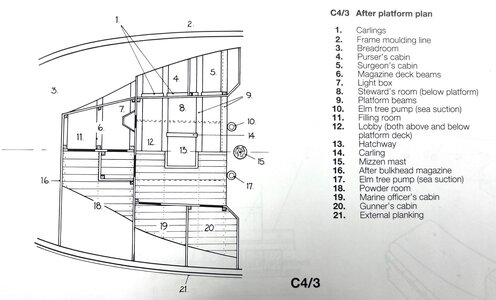
a first check
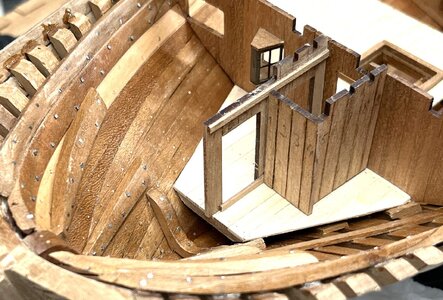
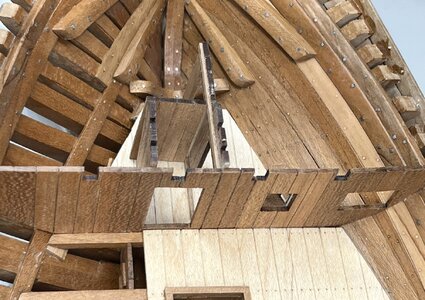
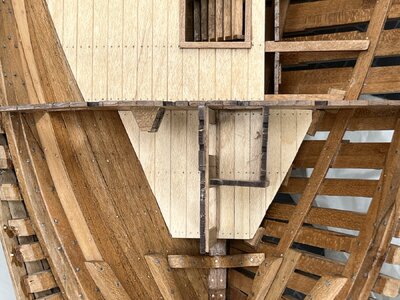
with installed after bulkhead it is easier to finalize - also here visible in the background the wall separating the bread-room, with the only entrance via the window
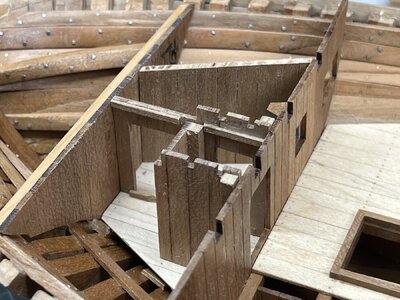
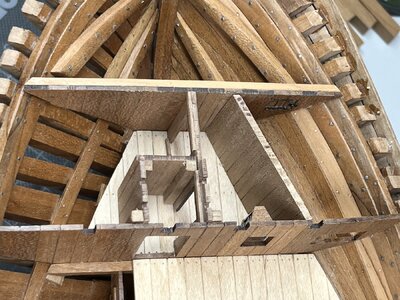
Interesting was the fact, that the british ships needed a bread room, because they stored the bread all over the complete journey - we can not imagine how good such bread was tasting, when it was stored several months in such a room
The french ships had usually a bread oven on board - so they had every day their fresh baguette on the table
The french lost in Trafalgar, but definitely they had a better breakfast in the morning
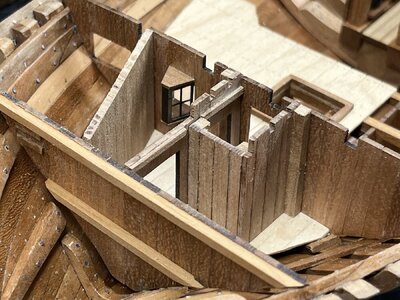
After fixing of the lighting box also the walls of the powder room and filing room with entrance door have to be prepared

a first check



with installed after bulkhead it is easier to finalize - also here visible in the background the wall separating the bread-room, with the only entrance via the window


Interesting was the fact, that the british ships needed a bread room, because they stored the bread all over the complete journey - we can not imagine how good such bread was tasting, when it was stored several months in such a room
The french ships had usually a bread oven on board - so they had every day their fresh baguette on the table
The french lost in Trafalgar, but definitely they had a better breakfast in the morning

The french lost in Trafalgar, but definitely they had a better breakfast in the morning



The filling room needed some lead or copper sheating - so I tried with some thin lead foil the coverage of the floor
a frist try
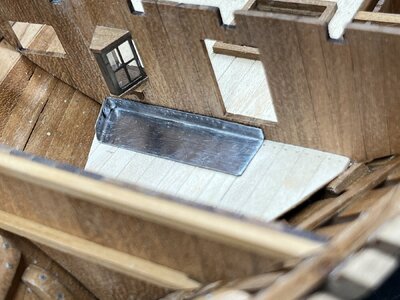
several strips have to be laid - overlapped
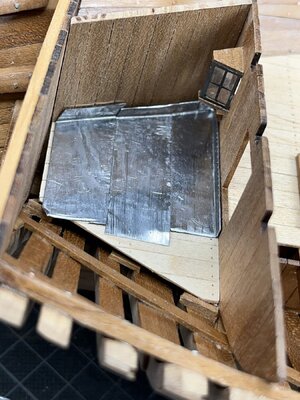
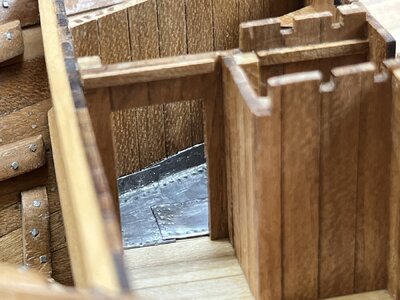
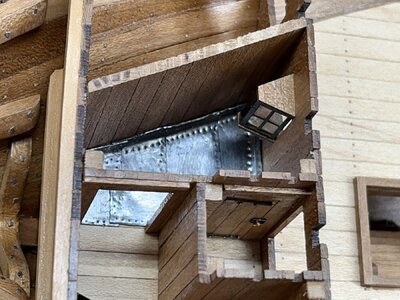
I am pretty sure, that they had at the time the ship was fitted not so big plates of lead, so I decided to make a patchwork quilt
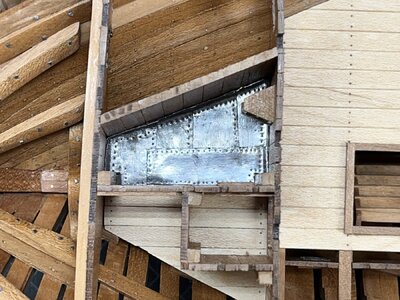
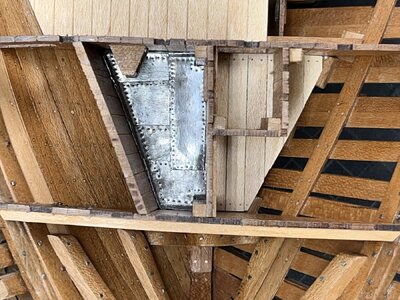
Many Thanks for your interest in my building log .... to be continued ....
a frist try

several strips have to be laid - overlapped



I am pretty sure, that they had at the time the ship was fitted not so big plates of lead, so I decided to make a patchwork quilt


Many Thanks for your interest in my building log .... to be continued ....
- Joined
- Dec 9, 2019
- Messages
- 950
- Points
- 403

Witaj
Bardzo fajnie wyglądają te płyty ołowiowe ale w jakim celu były montowane czyżby skład na proch? . Pozdrawiam Mirek
Hello
These lead plates look very nice, but for what purpose were they assembled? Was it a powder composition? . Regards, Mirek
Bardzo fajnie wyglądają te płyty ołowiowe ale w jakim celu były montowane czyżby skład na proch? . Pozdrawiam Mirek
Hello
These lead plates look very nice, but for what purpose were they assembled? Was it a powder composition? . Regards, Mirek
Last edited by a moderator:
A very nice detail to include. And so nicely done!The filling room needed some lead or copper sheating - so I tried with some thin lead foil the coverage of the floor
a frist try
View attachment 439849
several strips have to be laid - overlapped
View attachment 439850
View attachment 439851
View attachment 439852
I am pretty sure, that they had at the time the ship was fitted not so big plates of lead, so I decided to make a patchwork quilt
View attachment 439853
View attachment 439854
Many Thanks for your interest in my building log .... to be continued ....
The french lost in Trafalgar, but definitely they had a better breakfast in the morning

Nice details, Uwe: the patch work makes it realistic.The filling room needed some lead or copper sheating - so I tried with some thin lead foil the coverage of the floor
a frist try
View attachment 439849
several strips have to be laid - overlapped
View attachment 439850
View attachment 439851
View attachment 439852
I am pretty sure, that they had at the time the ship was fitted not so big plates of lead, so I decided to make a patchwork quilt
View attachment 439853
View attachment 439854
Many Thanks for your interest in my building log .... to be continued ....
Regards, Peter


